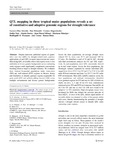Mostrar el registro sencillo del ítem
QTL mapping in three tropical maize populations reveals a set of constitutive and adaptive genomic regions for drought tolerance
| Autor: | Dias Almeida, G. |
| Autor: | Makumbi, D. |
| Autor: | Magorokosho, C. |
| Autor: | Nair, S.K. |
| Autor: | Borém, A. |
| Autor: | Ribaut, J.M. |
| Autor: | Bänziger, M. |
| Autor: | Prasanna, B.M. |
| Autor: | Crossa, J. |
| Autor: | Babu, R. |
| Año: | 2012 |
| ISSN: | 0040-5752 |
| URI: | http://hdl.handle.net/10883/3178 |
| Resumen: | Despite numerous published reports of quantitative trait loci (QTL) for drought-related traits, practical applications of such QTL in maize improvement are scarce. Identifying QTL of sizeable effects that express more or less uniformly in diverse genetic backgrounds across contrasting water regimes could significantly complement conventional breeding efforts to improve drought tolerance. We evaluated three tropical bi-parental populations under water-stress (WS) and well-watered (WW) regimes in Mexico, Kenya and Zimbabwe to identify genomic regions responsible for grain yield (GY) and anthesis-silking interval (ASI) across multiple environments and diverse genetic backgrounds. Across the three populations, on average, drought stress reduced GY by more than 50 % and increased ASI by 3.2 days. We identified a total of 83 and 62 QTL through individual environment analyses for GY and ASI, respectively. In each population, most QTL consistently showed up in each water regime. Across the three populations, the phenotypic variance explained by various individual QTL ranged from 2.6 to 17.8 % for GY and 1.7 to 17.8 % for ASI under WS environments and from 5 to 19.5 % for GY under WW environments. Meta-QTL (mQTL) analysis across the three populations and multiple environments identified seven genomic regions for GY and one for ASI, of which six mQTL on chr.1, 4, 5 and 10 for GY were constitutively expressed across WS and WW environments. One mQTL on chr.7 for GY and one on chr.3 for ASI were found to be ?adaptive? to WS conditions. High throughput assays were developed for SNPs that delimit the physical intervals of these mQTL. At most of the QTL, almost equal number of favorable alleles was donated by either of the parents within each cross, thereby demonstrating the potential of drought tolerant × drought tolerant crosses to identify QTL under contrasting water regimes. |
| Formato: | |
| Lenguaje: | English |
| Editor: | Springer |
| Copyright: | CIMMYT manages Intellectual Assets as International Public Goods. The user is free to download, print, store and share this work. In case you want to translate or create any other derivative work and share or distribute such translation/derivative work, please contact CIMMYT-Knowledge-Center@cgiar.org indicating the work you want to use and the kind of use you intend; CIMMYT will contact you with the suitable license for that purpose. |
| Tipo: | Article |
| Región: | Global |
| Páginas: | 583-600 |
| Número: | 3 |
| Volumen: | 126 |
| DOI: | 10.1007/s00122-012-2003-7 |
| URI del Editor : | http://www.springerlink.com/content/6647vv605x2x3024/ |
| País: | MEXICO |
| País: | KENYA |
| País: | ZIMBABWE |
| Agrovoc: | QUANTITATIVE TRAIT LOCI |
| Agrovoc: | MAIZE |
| Agrovoc: | TROPICAL ZONES |
| Agrovoc: | GENE EXPRESSION |
| Agrovoc: | DROUGHT TOLERANCE |
| Revista: | Theoretical and Applied Genetics |
Ficheros en el ítem
Este ítem aparece en la(s) siguiente(s) colección(ones)
-
Maize
Maize breeding, phytopathology, entomology, physiology, quality, and biotech

